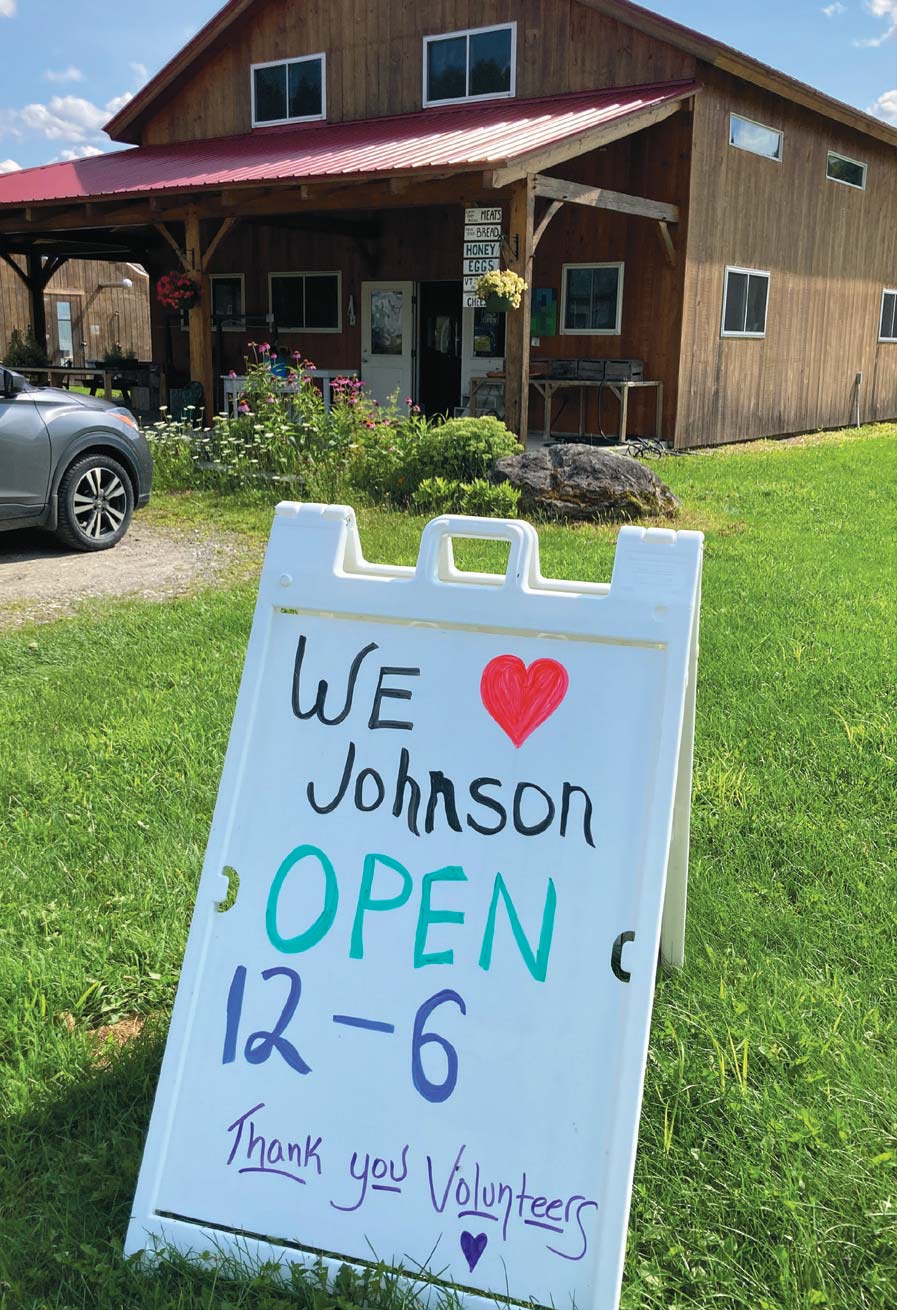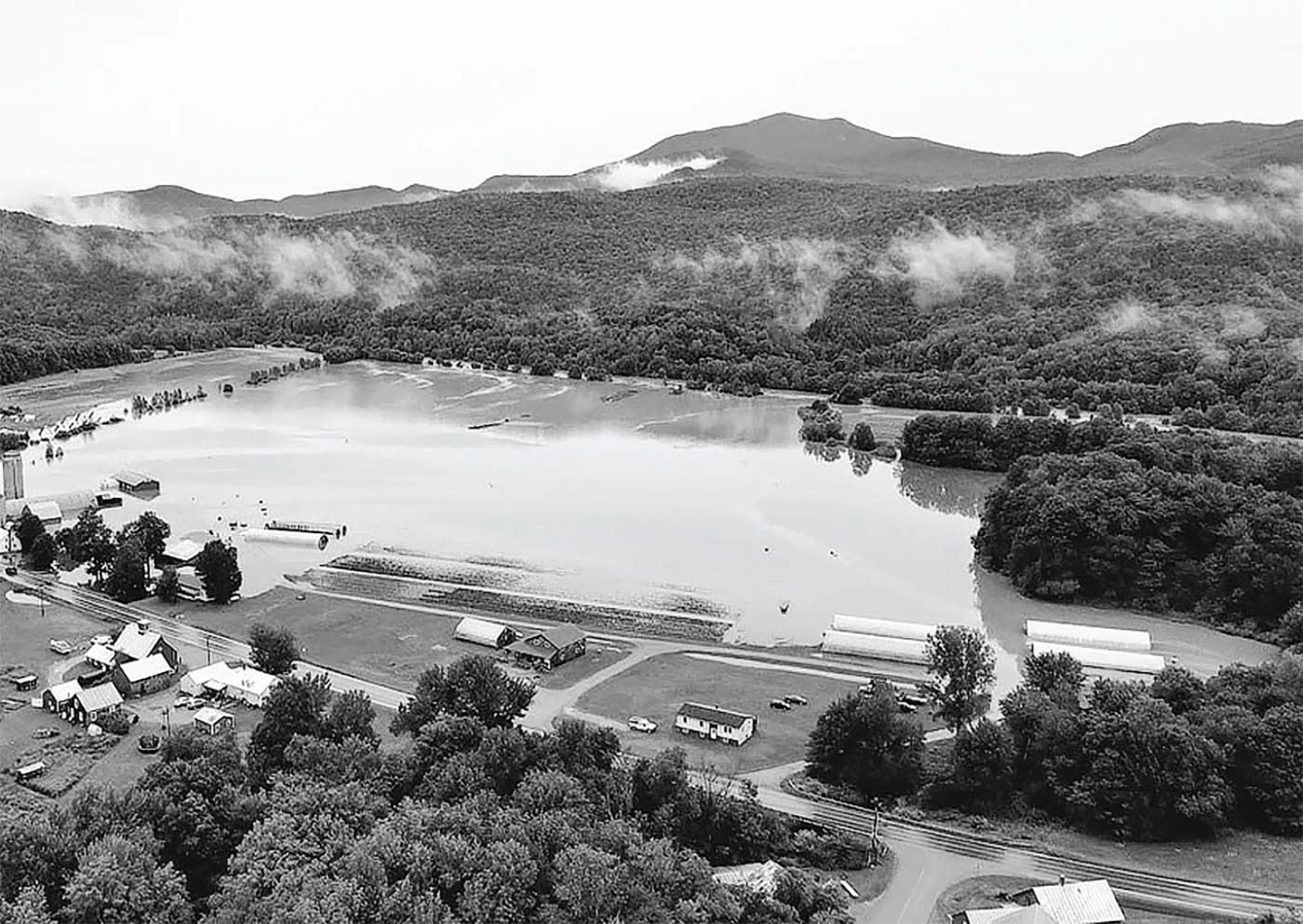Foote Brook Farm, Johnson: Joie Lehouillier, Co-Owner
Tony and Joie Lehouillier are the third generation of the Lehouillier family to steward Foote Brook Farm. One of the top 10 largest certified organic farms in Vermont, they ship their product through Deep Root Organic Co-op, whose operations center is right next to the farm on Route 15. Six feet of water flooded that facility as well, but the business was up and running within a week.
If you wouldn’t mind, just walk me through what happened on July 10 and 11 and how your farm has been impacted.
So, the rain came on Monday, July 10. Tony and I sent everybody home early because the rivers were starting to get full, and we wanted to make sure people could make it home safely. And then we just watched the NOAA website every hour, checking to see what the river gauge was going to predict. About 11 o’clock Monday night, it said that the Lamoille River was going to crest around 18½ feet, which is above flood stage at 13 feet. We knew we would have substantial flooding but didn’t think it was going to be disastrous.
We thought we’re going to lose the onions and probably a round of lettuce or two. We were sad, but it was what it was. We moved the equipment as far in as we thought we needed to, and we went to bed. We woke up on Tuesday morning around 4 a.m. It was light out. There was no traffic, and it didn't feel right. I said to Tony, “We need to go look at this together. I don’t want to go out there by myself.” When we walked out, it was so quiet, and the water was right outside our door. It was absolutely shocking. We just stood there. There was nothing we could do. The water had already come up so far that we couldn’t go move tractors. We couldn’t do anything to save the stuff in the barn. We could get from our house to the farm stand and then to our employee’s house, but we couldn’t get to anything else.
Tony went to move some lawn tractors and kayaks that we didn’t want floating down the river. He almost couldn’t get back to the house because the water was still coming up and really rushing, and it created this river in our backyard. We just spent the day with our employees who live here on the farm, and just waited. The water came in quick, and it left pretty quick. By noon on Tuesday afternoon, the river had already receded significantly. Tony took a kayak out to the three upper fields to just see if the winter squash had gone underwater. Then we just waited until we could start to get around the farm to assess the destruction.
What descriptors do you use?
Shock and total devastation. As farmers, you lose crops every year. We were just like, wow, that was a real lot of work that is just gone. But the devastation really didn’t come until we could get over to the barn and to the shop. Seeing what happened to the equipment took years off Tony’s life. The farm has been in the Lehouillier family since the 1950s. This is equipment that Tony’s dad purchased 30, 40 years ago. We’ve built our farming practices around that equipment, and we can’t do anything without that.
So the barn itself got flooded?
The barn had about 5½ feet of water in it. It lifted up everything and just tossed everything. Even giant industrial ice machines. It ruined all our packaging, $10,000 worth of fertilizer, our rolls of reemay row cover [agricultural fabric placed over crops]. Anything that you could imagine a farm uses for supplies, it was all in there. Our vegetable washroom equipment, ruined.
The community was absolutely everything. We literally would not be open if the community didn’t come out. We had our friends, our family, my son’s AAU basketball community—all those families and their kids came, and everybody just showed up and just said, “Tell us what to do.” –Joie Lehouillier, Foote Brook Farm
In those first few days or so, I’m sure you guys must’ve felt like that’s it, we’re done.
Very true. When we woke up on Wednesday morning, we were really just like, okay, it’s over. We have to send everybody home. There’s nothing we can do. We don’t have any equipment. We don’t have anything. And then on Wednesday morning—we have two family members who are heavy equipment mechanics, and they literally left their jobs for the rest of the week and came here to help. They took every single tractor and drained all the fluid, cleaned them out, put new fluids back in, and started them up. Everybody was cheering and clapping, and it was incredible.
However, the problem is that anytime a piece of equipment like that is flooded, you probably will not keep it running, or you will have to constantly be tinkering with it. So even though those guys got everything up and running—which was incredible and they’ll be getting free vegetables for the rest of their lives—that equipment is still really compromised, and it’s going to run my husband into the ground trying to keep up with it. It’s hundreds of thousands of dollars to try to replace that kind of equipment. That’s where we really have to think about how do we move forward and what changes do we have to make because we just don’t have the infrastructure anymore to do it the way we were doing it.
Talk about the support of your community.
Oh, the community was absolutely everything. We literally would not be open if the community didn’t come out. We had our friends, our family, my son’s AAU basketball community—all those families and their kids came, and everybody just showed up and just said, “Tell us what to do.” They cleaned up the barn, they helped us strip kale, they did whatever we needed.
Their presence gave us the will to move forward. “Okay, we’re going to get through this season, and we’re going to keep going.”

Signboard in front of Foote Brook Farm conveys the farm family’s sincere gratitude. Photo: Maria Buteux Reade.
How are you guys feeling now? We’re speaking exactly a month after the flood.
It changes every day, sometimes moment to moment. Tony and I are happy, positive people. Yes, we have bad days and get frustrated, and it makes you not want to farm anymore. But Tony and I don’t—can’t—give up. Things break, he persists and fixes them, and we move on. So it’s a real roller coaster of emotions day to day, honestly.
Again, Joie, thank you for taking the time and emotional energy to share your story. I know dredging up the memories is exhausting.
I know this is our story, but I’m also thinking about all the other farmers who got hit around the state. Farming is incredibly difficult, and every farm is important whatever size they are. There just needs to be a lot of appreciation for anybody who is growing food for their community. But farms that are our size in Vermont create real food security. So it’s important to create some awareness around the fact that we’re huge economic drivers, too. That money goes into our communities and into all the businesses in Vermont that supply us to let us run our business. And when disasters and challenges like this happen, we need help to make sure that we’re set up to be able to survive them in the future because they’re not going to stop coming.




